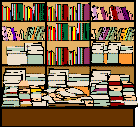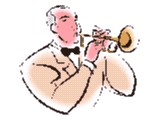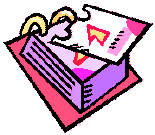

For this section, the classification system that will be referred to is the Dewey Decimal Classification System (DDC), and the version of the DDC being used is the abridged 13 ed.
Classification is an important part of the cataloging process, as this is the step that gives the item being cataloged its ‘address’ in the library collection. There are several ways to approach this for non-book items, whatever format they are.
One way to place items in the collection is to have everything shelved in one classification order, without regard to the format of the items. This is called integrated shelving, and means that no matter what format an item is, all materials on a particular topic will be found together on the shelf in the library. There are advantages to this system, especially that the patron or staff can find all the materials on a given topic in one area of shelving. Disadvantages include things like the special packaging needed to be able to safely shelve most non-book materials side by side with books without damage, and the fact that this type of organization usually takes up more shelf space than other organizational designs.

Another type of shelving arrangement involves keeping each different format separately arranged in the library. This is called separate shelving, and is the way most libraries are organized. Separate shelving has disadvantages, including the fact that to find all of the materials on a given topic, the patron or staff member will have to go to several areas of the library collection. Advantages of separate shelving include saving space through shelving set to the sizes needed for each type of format, and the idea that the collection can be more easily browsed by format, so if a patron is just looking for a video, he or she doesn’t have to look through other formats also.
When separate shelving is used, there are still some options as far as how the ‘address’ for each format might be created. Generally, libraries choose one or two options. The first option is to treat non-fiction and fiction items just as books in those areas would be treated, using classification numbers to create the call number, or address, for all of the non-book items. Often, as part of those call numbers, an indicator of the format of the item is added as the first line of the call number, to alert the user to the format of the item. This way of constructing the call number would also be the style used for integrated shelving, if a library chose to take that approach.
MUSIC CD
786.8 Bells for all seasons [sound recording] / the handbell artistry of
HOL Lois Holland. – Nashville, TN : Holland, p1982.
1982 1 sound disc : digital, stereo ; 4 ¾ in.
KLP-1001 Holland
Contents: Golden memories – His eye is on the sparrow
The cross – My country, ‘tis of thee ; Faith of our fathers – How
Great Thou art – I’ll fly away ; Jesus is coming again – Thanksgiving
Praise – What child is this? – Silent night – Christmas medley.
Cast: Lois Holland, handbells, flute and keyboards ; Ken
Holland, keyboards, bass, guitar, and percussion.
1. Handbell music. 2. Contemporary Christian music.
3. Christmas music. I. Holland, Lois. II. Holland, Ken.

Another way of organizing non-book items in the library is to assign an accession number to each item as it arrives in the library, and then shelve the items in numerical order based on that number. In this type of organizational design, the order items are placed in depends on when something arrived in the collection, with the older items usually having smaller numbers, and later additions the larger numbers. This can be a very easy way to organize materials, but has the disadvantage of not being very browseable. When there is no subject organization to an arrangement of materials in the library, patrons and staff will need to rely on other access possibilities, such as the library catalog, to be able to browse by subject, title, or name.
A variation of the above design, made to try to help in the browsing of the non-book collection, is where materials such as sound recordings are treated more like fictional materials are in most libraries, and are given an address based on the title or the ‘author’ of the work. This type of arrangement must be carefully thought out, or the library finds itself with materials that might fall into more than one place in this design, and will have difficulty deciding where to place those items. The advantage of this type of organization is that items by composers, such as Mozart, can be grouped together, Christmas music can be grouped together, popular songs can be together, etc. But this must be carefully planned out to allow for some materials that don’t fit clearly into broad categories. Another variation of this design is to use the publisher’s catalog or order number. This groups all items from one publisher or distributor together, but again doesn’t allow for browsing very well.
|
LC Control Number: |
2002598667 |
|
Type of Material: |
Music Sound Recording |
|
Corporate Name: |
|
|
Main Title: |
Colors of love [sound recording]. |
|
Published/Created: |
Hamburg, Germany : Teldec Classics, p1999. |
|
Related Names: |
Jennings, Joseph, 1954- cnd |
|
Description: |
1 sound disc : digital, stereo. ; 4 3/4 in. |
|
Publisher Number: |
3984-24570-2 Teldec Classics |
|
Contents: |
Cradle songs / Steven Stucky -- Village wedding / John Tavener -- From Canti d'amor / Bernard Rands -- Words of the sun / Zhou Long -- From Tang poems / Chen Yi -- The rub of love / Augusta Read Thomas -- In time of / Steven Sametz -- From Love songs / Augusta Read Thomas. |
|
Notes: |
Choral works sung by unacc. male vocal ensemble. |
|
Cast: |
Chanticleer; Joseph Jennings, conductor. |
|
Subjects: |
|
|
LC Classification: |
SDA 51433 |
Looking at the example above from the Library of Congress online catalog, it is possible to see that the Library of Congress tends to use an accession-type organization for their sound recordings. The classification number on this item is ‘SDA 51433’, so that would be the address, or call number, of this item in the Library of Congress. This example also points out one area that isn’t very helpful when copying cataloging from the Library of Congress. For print material, most MARC records and cataloging records will have either or both a Library of Congress classification number and a Dewey classification number. With non-book items, this is not usually the case. Because there are so many different ways that libraries organize non-print materials, there is much less consistency in how call numbers are created, and the chances of finding a classification number in a copied cataloging record are much slimmer.

If a library chooses to use the option of a classification scheme, in the DDC, the 780’s are the classification numbers for various types of music. Fitting all types of music into one 10-number range means that many of the numbers have the potential of being rather long. For this reason, many libraries are reluctant to use Dewey to organize their music collections. If used carefully, though, Dewey can work as effectively for sound recordings as it works for any other library format.
In Dewey, the 780’s are broken down into the following ranges:
780 Music
781 General principles and forms
782 Vocal music
783 Music for single voices
784 Instruments and instrumental ensembles
785 Ensembles with only one instrument per part
786 Keyboard, percussion
787 Stringed instruments
788 Wind instruments

Within each of these categories are options for many different types of music, but the emphasis of this section leans toward classical and church-based music. The various types of popular music are found in the general section, 781.6, and in the vocal music section, 782.4. The section 783 deals specifically with solo voice, so some popular music can be listed here as well as classical music. The range of 784-788 is used primarily for various instruments and ensembles of classical music, but other types of musical form could be entered here if it fits the guidelines specified in the scope notes for each section. As emphasized in the classification section of the ABLE Technical Services course, it is very important to read all of the scope notes for each section you are using in the DDC. These notes give specific information about when numbers can or can’t be used, and often give recommendations of other numbers or ranges that might be used instead.

|
LC Control Number: |
93725082 |
|
Type of Material: |
Music Sound Recording |
|
Main Title: |
Beatle country [sound recording] / all songs composed by John Lennon and Paul McCartney. |
|
Published/Created: |
New York City : Elektra, [1966] |
|
Related Names: |
Lennon, John, 1940-1980. |
|
Description: |
1 sound disc : digital, stereo. ; 4 3/4 in. |
|
Publisher Number: |
EKS-74006 Elektra |
|
Contents: |
I've just seen a face -- Baby's in black -- I feel fine -- Yellow submarine -- Ticket to ride -- And your bird can sing -- What goes on -- Norwegian wood -- Paperback writer -- She's a woman -- I saw her standing there -- Help! |
|
Notes: |
Brief record. |
|
Cast: |
The Charles River Valley Boys. |
|
Subjects: |
|
|
Dewey Class No.: |
CD 781.642 Beatle 1966 |
In the example above, the DDC number of 781.642 was assigned to this work. Even though the music being played is popular rock music, the format it is being played in is country bluegrass, so the classification number given indicates bluegrass.

This next example is in card catalog format, and has been given the DDC number of 784.2. This recording has both vocal and orchestral music, but in looking under 782, the Vocal Music section of the DDC, there is a note indicating that orchestral music with vocal parts should be placed in 784.2. These notes are very helpful in the process of determining the correct area of the Dewey classification to place different types of music recordings.
CD
784.2 The Faure requiem and other works [sound recording]. --
FAURE [S.l.] : Grotto Productions, p1998.
1998 1 sound disc : digital, stereo ; 4 ¾ in.
N34D8 Grotto Productions
Contents: Requiem, op. 48 / Gabriel Faure – [etc.]
1. Orchestral music. I. Faure, Gabriel.

This final example is another computer catalog format from the Library of Congress. This recording is a collection of jazz pieces with several performers. The Dewey number for Jazz is 781.65, so that is the classification given to this record. For the author number, Miles Davis is used because he has been made the main entry of this record. This can be seen by the ‘Personal Name’ entry line in the cataloging record, and is more evident in the coding for the MARC record for this item. With the variations in format from one computer catalog display to another, many times the MARC record is the best way to clearly determine questions such as the choice of main entry, and what other access points are being added.
|
LC Control Number: |
91761620 |
|
Type of Material: |
Music Sound Recording |
|
Personal Name: |
|
|
Main Title: |
Miles Davis all stars [sound recording] : live in 1958-59. |
|
Published/Created: |
[S.l.] : Jazz Band, p1990. |
|
Related Names: |
|
|
Description: |
1 sound disc : digital, stereo. ; 4 3/4 in. |
|
Publisher Number: |
EBCD 2101-2 Jazz Band |
|
Contents: |
Introduction. Walkin' -- All of you -- Introduction. Sid's ahead -- Bye bye blackbird -- Straight no chaser -- Introduction. Four -- Bye bye blackbird -- No blues -- Closing announcement (Wha happened) -- What is this thing called love? |
|
Notes: |
Compact disc. |
|
Cast: |
Featuring John Coltrane ; and various performers. |
|
Subjects: |
|
|
Dewey Class No.: |
CD 781.65 DAVIS 1990 |
After the decision has been made about the type of organizational design to be used for non-book materials and the first part of the sound recording’s address has been decided, it is important to finish the call number in a consistent manner with other call numbers in the library. There are several ways to create the components in a complete call number. These are all covered in detail in the ABLE Technical Services courses, but included here is a short reminder of the options many libraries use.

After determining the classification number or accession number, the next element in a call number is the author number. This can be one of several choices. Many libraries use the Library of Congress Cutter Table, a listing of letters and their numerical equivalents to use in abbreviating the main entry, either the author’s last name or the start of the title.
This Cutter Table is available online, at http://130.15.161.74/techserv/lc-cut.html or there are variations of other Cutter Tables that are also available at online sites.
Here is a section of the LC table, showing the type of information it gives the cataloger. To use the table, keep the first letter of the main entry, then add numbers for the next 2 or 3 letters in the word, to create an author number that is 3 or 4 characters long. Using this table, the author number for Mozart would be M693, and the author number for the title Appalachian Spring would be A673.
| 1) After initial vowels | ||||||||
| for the second letter: | b | d | l-m | n | p | r | s-t | u-y |
| use number: | 2 | 3 | 4 | 5 | 6 | 7 | 8 | 9 |
| 2) After other initial consonants | |||||||
| for the second letter: | a | e | i | o | r | u | y |
| use number: | 3 | 4 | 5 | 6 | 7 | 8 | 9 |
| 3) For expansion | |||||||
| for the letter: | a-d | e-h | i-l | m-o | p-s | t-v | w-z |
| use number: | 3 | 4 | 5 | 6 | 7 | 8 | 9 |
It is quite easy to create an author number using a Cutter Table, and they are designed so that almost all of the time, the author number created will help the materials being cataloged fall into alphabetical order on the shelves.
Another way to create an author number is to use all or part of the author’s name or the beginning word of the title. Many libraries choose this option instead of using a Cutter Table. This would mean that works by Mozart would have an author number of MOZ or MOZART, and the author number for Appalachian Spring would be APP or APPALACHIAN. If your library chooses this style of author number, it is important to be consistent in the number of letters chosen. If the full name or word is used, make sure that rule is followed, no matter how long the word might be. If there are cases where the same last name is repeated with a different first name, as with the various composers named ‘Bach’, then decisions will have to be made about additions to the author number to allow for alphabetizing of the materials on the shelf.
After the author number is chosen, the next element in a call number may be a title number. This is determined in the same way the author number is, and is used to further break down those authors who may have several different works in the same subject area. For example, there are several symphonies by Beethoven, so after giving these the author number of B448, further breakdown would be needed by the names or numbers of the symphonies. Title numbers are not always needed, but when cataloging in an area like music sound recordings where there are many prolific composers and performers, it is a good practice to use all of the time.

The last element usually put into a call number is the date of publication. This can be a useful part of a call number for materials that might have multiple editions. By indicating the date as part of the call number, the subsequent editions are shelved in chronological order together on the library shelf. This can also be used in music sound recordings to differentiate between different recordings of the same work, for example a recording of Appalachian Spring from 1969 vs. one from 2002. When there are many versions of the same work, adding the date can be helpful in creating that unique address that is the purpose of the call number.
Occasionally, if the library owns more than one copy of the exact same item, a copy number is needed at the end of the call number. This is not a usual occurrence with music sound recordings, but could happen with popular recordings of Christmas music or well known classical pieces. This copy number is only added if the copy is exactly the same as something already in the collection. It is usually added at the end of the call number as ‘c.2’ or ‘copy 2’, depending on how each individual library chooses to list this information. Again, consistency is important, so whatever way multiple copies are indicated in the rest of the collection should be the way that it is also used for music sound recordings.
Careful thought should be put into the structure of the call number, or address, for all materials in the library, but there are elements such as the author number and title number that can be very effectively used in the cataloging of music sound recordings to help organize your collection in a way that is helpful for the patrons or staff trying to find materials on the library shelves.
Click the arrow below to continue.